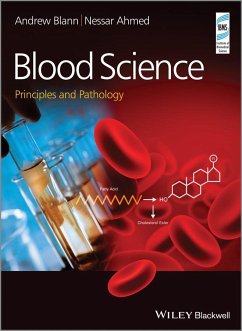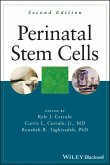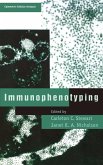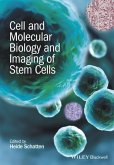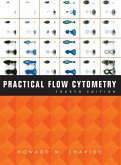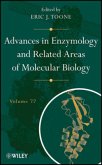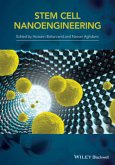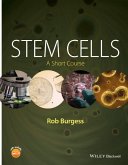- Gebundenes Buch
- Merkliste
- Auf die Merkliste
- Bewerten Bewerten
- Teilen
- Produkt teilen
- Produkterinnerung
- Produkterinnerung
Blood Science is a relatively new discipline which merges biochemistry, haematology, immunology, transfusion science and genetics. This bringing together of traditional disciplines requires a corresponding change in education and training for healthcare scientists and Blood Science: Principles and Pathology is written in response to this emerging need.
An introduction to the subject and an overview of the techniques used in blood science are followed by a series of chapters based on groups of analytes investigated in blood - red blood cells, white blood cells and platelets, followed by the…mehr
Andere Kunden interessierten sich auch für
![Perinatal Stem Cells Perinatal Stem Cells]() Perinatal Stem Cells169,99 €
Perinatal Stem Cells169,99 €![Immunophenotyping Immunophenotyping]() R. A. BrayImmunophenotyping292,99 €
R. A. BrayImmunophenotyping292,99 €![Cell and Molecular Biology and Imaging of Stem Cells Cell and Molecular Biology and Imaging of Stem Cells]() Cell and Molecular Biology and Imaging of Stem Cells163,99 €
Cell and Molecular Biology and Imaging of Stem Cells163,99 €![Practical Flow Cytometry Practical Flow Cytometry]() Howard M. ShapiroPractical Flow Cytometry218,99 €
Howard M. ShapiroPractical Flow Cytometry218,99 €![Advances in Enzymology and Related Areas of Molecular Biology, Volume 77 Advances in Enzymology and Related Areas of Molecular Biology, Volume 77]() Advances in Enzymology and Related Areas of Molecular Biology, Volume 77156,99 €
Advances in Enzymology and Related Areas of Molecular Biology, Volume 77156,99 €![Stem-Cell Nanoengineering Stem-Cell Nanoengineering]() H. BaharvandStem-Cell Nanoengineering166,99 €
H. BaharvandStem-Cell Nanoengineering166,99 €![Stem Cells Stem Cells]() Rob BurgessStem Cells93,99 €
Rob BurgessStem Cells93,99 €-
-
-
Blood Science is a relatively new discipline which merges biochemistry, haematology, immunology, transfusion science and genetics. This bringing together of traditional disciplines requires a corresponding change in education and training for healthcare scientists and Blood Science: Principles and Pathology is written in response to this emerging need.
An introduction to the subject and an overview of the techniques used in blood science are followed by a series of chapters based on groups of analytes investigated in blood - red blood cells, white blood cells and platelets, followed by the constituents of plasma, including waste products, electrolytes, glucose, lipids, enzymes, hormones, nutrients, drugs, poisons and others.
Each chapter is supported by learning objectives, summaries and further information, and a focus is given to chapter specific case studies with interpretation to demonstrate how laboratory data in conjunction with clinical details is utilised when investigating patients with actual or suspected disease. Finally, a separate chapter offers more detailed case reports that integrate the different aspects of blood science.
Undergraduate students taking blood science modules as part of their BSc programmes in Biomedical and Healthcare Sciences will appreciate the level of integration between clinical biochemistry and haematology. In addition, this book will provide suitable initial reading for those students embarking on blood science modules on MSc programmes and will be of value to new graduates entering the profession and starting their career in blood science departments by supplementing practice-based training with the required theoretical underpinning.
This book is approved by the Institute of Biomedical Science and written by its expert writers, many of whom work on the Institute's advisory panels.
Hinweis: Dieser Artikel kann nur an eine deutsche Lieferadresse ausgeliefert werden.
An introduction to the subject and an overview of the techniques used in blood science are followed by a series of chapters based on groups of analytes investigated in blood - red blood cells, white blood cells and platelets, followed by the constituents of plasma, including waste products, electrolytes, glucose, lipids, enzymes, hormones, nutrients, drugs, poisons and others.
Each chapter is supported by learning objectives, summaries and further information, and a focus is given to chapter specific case studies with interpretation to demonstrate how laboratory data in conjunction with clinical details is utilised when investigating patients with actual or suspected disease. Finally, a separate chapter offers more detailed case reports that integrate the different aspects of blood science.
Undergraduate students taking blood science modules as part of their BSc programmes in Biomedical and Healthcare Sciences will appreciate the level of integration between clinical biochemistry and haematology. In addition, this book will provide suitable initial reading for those students embarking on blood science modules on MSc programmes and will be of value to new graduates entering the profession and starting their career in blood science departments by supplementing practice-based training with the required theoretical underpinning.
This book is approved by the Institute of Biomedical Science and written by its expert writers, many of whom work on the Institute's advisory panels.
Hinweis: Dieser Artikel kann nur an eine deutsche Lieferadresse ausgeliefert werden.
Produktdetails
- Produktdetails
- Verlag: Wiley & Sons
- 1. Auflage
- Seitenzahl: 556
- Erscheinungstermin: 17. März 2014
- Englisch
- Abmessung: 246mm x 196mm x 28mm
- Gewicht: 1225g
- ISBN-13: 9781118351383
- ISBN-10: 111835138X
- Artikelnr.: 40048698
- Herstellerkennzeichnung
- Libri GmbH
- Europaallee 1
- 36244 Bad Hersfeld
- gpsr@libri.de
- Verlag: Wiley & Sons
- 1. Auflage
- Seitenzahl: 556
- Erscheinungstermin: 17. März 2014
- Englisch
- Abmessung: 246mm x 196mm x 28mm
- Gewicht: 1225g
- ISBN-13: 9781118351383
- ISBN-10: 111835138X
- Artikelnr.: 40048698
- Herstellerkennzeichnung
- Libri GmbH
- Europaallee 1
- 36244 Bad Hersfeld
- gpsr@libri.de
Dr Andrew Blann, FRCPath FIBMS CSci, Consultant Clinical Scientists and Honorary Senior Lecturer in Medicine, University Department of Medicine, UK; Deputy Chief Examiner in Haematology with the Institute of Biomedical Science and an Examiner in Haematology with the Royal College of Pathologists. Dr Nessar Ahmed, CSci FIBMS, Reader in Clinical Biochemistry, School of Healthcare Science, Manchester Metropolitan University, UK.
Preface
xiii Acknowledgements
xv List of Abbreviations
xvii About the Companion Website
xxi 1 Introduction to Blood Science
1 1.1 What is blood science?
1 1.2 Biochemistry
6 1.3 Blood transfusion
8 1.4 Genetics
10 1.5 Haematology
14 1.6 Immunology
17 1.7 The role of blood science in modern healthcare
19 1.8 What this book will achieve
22 Summary
23 References
23 Further reading
23 Web sites
23 2 Analytical Techniques in Blood Science
25 2.1 Venepuncture
25 2.2 Anticoagulants
26 2.3 Sample identification and tracking
27 2.4 Technical and analytical confidence
27 2.5 Major techniques
32 2.6 Molecular genetics
43 2.7 Point of care testing
47 2.8 Health and safety in the laboratory
48 Summary
49 Further reading
50 Web sites
50 3 The Physiology of the Red Blood Cell
51 3.1 Introduction
51 3.2 The development of blood cells
52 3.3 Erythropoiesis
56 3.4 The red cell membrane
58 3.5 The cytoplasm of the red cell
60 3.6 Oxygen transport
66 3.7 Recycling the red cell
68 3.8 Red cell indices in the full blood count
69 3.9 Morphology of the red cell
72 Summary
74 Further reading
74 4 The Pathology of the Red Blood Cell
75 4.1 Introduction: diseases of red cells
75 4.2 Anaemia resulting from attack on
or stress to
the bone marrow
78 4.3 Anaemia due to deficiency
80 4.4 Intrinsic defects in the red cell
85 4.5 External factors acting on healthy cells
100 4.6 Erythrocytosis and polycythaemia
103 4.7 Molecular genetics and red cell disease
105 4.8 Inclusion bodies
105 4.9 Case studies
105 Summary
107 References
107 Further reading
107 5 White Blood Cells in Health and Disease
109 5.1 Introduction
109 5.2 Leukopoiesis
111 5.3 Neutrophils
115 5.4 Lymphocytes
116 5.5 Monocytes
117 5.6 Eosinophils
118 5.7 Basophils
119 5.8 Leukocytes in action
120 5.9 White cells in clinical medicine
127 5.10 Case studies
132 Summary
132 Further reading
133 6 White Blood Cell Malignancy 135 6.1 The genetic basis of leukocyte malignancy
135 6.2 Tissue techniques in haemato-oncology
139 6.3 Leukaemia
141 6.4 Lymphoma
149 6.5 Myeloma and related conditions
152 6.6 Myelofibrosis and myelodysplasia
157 6.7 Case studies
157 Summary
158 Further reading
159 Guidelines
159 7 The Physiology and Pathology of Haemostasis
161 7.1 The blood vessel wall
162 7.2 Platelets
163 7.3 The coagulation pathway
165 7.4 Haemostasis as the balance between thrombus formation and removal
168 7.5 The haemostasis laboratory
171 7.6 The pathology of thrombosis
173 Summary
175 Further reading
175 8 The Diagnosis and Management of Disorders of Haemostasis
177 8.1 Thrombosis 1: overactive platelets and thrombocytosis
177 8.2 Thrombosis 2: overactive coagulation
181 8.3 Haemorrhage 1: platelet underactivity and thrombocytopenia
193 8.4 Haemorrhage 2: coagulation underactivity
199 8.5 Disseminated intravascular coagulation
203 8.6 Molecular genetics in haemostasis
204 8.7 Case studies
205 Summary
206 References
206 Further reading
207 Guidelines
207 Web sites
207 9 Immunopathology
209 9.1 Introduction
209 9.2 Basics of the immune system
210 9.3 Humoral immunity
212 9.4 Immunopathology 1: immunodeficiency
215 9.5 Immunopathology 2: hypersensitivity
221 9.6 Immunopathology 3: autoimmune disease
226 9.7 Immunotherapy
232 9.8 The immunology laboratory
234 9.9 Case studies
238 Summary
239 References
240 Further reading
240 Guidelines
240 Web sites
240 10 Immunogenetics and Histocompatibility
241 10.1 The genetics of antigen recognition
241 10.2 Human leukocyte antigens
245 10.3 Transplantation
251 10.4 Autoimmunity and human leukocyte antigens
257 Summary
260 Further reading
260 Guidelines
260 Web sites
260 11 Blood Transfusion
261 11.1 Blood collection and processing
262 11.2 Blood groups
265 11.3 Laboratory practice of blood transfusion
273 11.4 Clinical practice of blood transfusion
279 11.5 Hazards of blood transfusion
281 Summary
284 References
284 Further reading
284 Guidelines
284 Web sites
285 12 Waste Products
Electrolytes and Renal Disease
287 12.1 Renal anatomy and physiology
287 12.2 Homeostasis
288 12.3 Excretion
295 12.4 Renal endocrinology
297 12.5 Renal disease
298 12.6 Case studies
301 Summary
303 Further reading
303 Guidelines
303 Web sites
303 13 Hydrogen Ions
pH
and Acid-Base Disorders
305 13.1 Ions and molecules
305 13.2 Blood gases
308 13.3 Acidosis (pH <7.3)
312 >7.5)
313 13.5 Mixed acid-base conditions
314 13.6 Clinical interpretation
314 13.7 Case studies
315 Summary
316 Further reading
317 Web site
317 14 Glucose
Lipids and Atherosclerosis
319 14.1 Glucose
319 14.2 Dyslipidaemia
333 14.3 Atherosclerosis
343 14.4 Case studies
347 Summary
348 Further reading
348 Guidelines
349 Web sites
349 15 Calcium
Phosphate
Magnesium and Bone Disease
351 15.1 Calcium
352 15.2 Phosphates
355 15.3 Magnesium
355 15.4 The laboratory
355 15.5 Disorders of calcium homeostasis
357 15.6 Disorders of phosphate homeostasis
360 15.7 Disorders of magnesium homeostasis
362 15.8 Bone physiology
363 15.9 Bone disease
364 15.10 Case studies
368 Summary
369 Further reading
370 Guidelines
370 Web sites
370 16 Nutrients and Gastrointestinal Disorders
371 16.1 Nutrients
371 16.2 The intestines
375 16.3 Case studies
381 Summary
382 Further reading
382 Guidelines
382 17 Liver Function Tests and Plasma Proteins
383 17.1 Anatomy and physiology of the liver
384 17.2 Liver function tests
389 17.3 Diseases of the liver
390 17.4 Plasma proteins
396 17.5 Case studies
405 Summary
406 Further reading
406 Web sites
406 18 Hormones and Endocrine Disorders
407 18.1 Endocrine physiology
407 18.2 The pathology of the endocrine system
417 18.3 Case studies
434 Summary
435 Further reading
435 Web sites
436 19 Cancer and Tumour Markers
437 19.1 General concepts in cancer biology
437 19.2 Blood science and cancer
440 19.3 Molecular genetics
444 19.4 Case studies
445 Summary
446 Further reading
446 Guidelines
447 Web sites
447 20 Inherited Metabolic Disorders
449 20.1 The genetics of inheritance
449 20.2 Molecular inherited metabolic disorders
451 20.3 Organelle inherited metabolic disorders
455 20.4 Antenatal diagnosis and neonatal screening
455 20.5 Case studies
456 Summary
457 Further reading
457 21 Drugs and Poisons
459 21.1 Toxicology
459 21.2 Toxicology of specific compounds
461 21.3 Therapeutic drug monitoring
465 21.4 Case studies
468 Summary
469 References
469 Further reading
469 22 Case Reports in Blood Science
471 Abbreviations
471 Case report 1
472 Anaemia
hypercalcaemia
proteinuria
myeloma Case report 2
473 Diabetes
glycated haemoglobin
chronic renal failure Case report 3
474 Acute kidney injury
leucocytosis
neutrophilia
viruses Case report 4
475 Part 1: Obesity
colorectal cancer
CEA
hypothyroidism. Part 2: Alcoholism
raised GGT and triacylglycerols Case report 5
477 Part 1: No abnormalities. Part 2: Asthma
raised IgE. Part 3: Falling haemoglobin
rising ESR
lung cancer Case report 6
479 Hypothyroidism
marginally reduced haemoglobin Case report 7
480 Raised CRP
ESR
rheumatoid factor and anti-nuclear antibodies; borderline anti-dsDNA antibodies
low C3
low eGFR and so mild renal failure
systemic lupus erythematosus Case report 8
481 Normal blood results in renal transplantation Case report 9
482 Falling albumin
eGFR
haemoglobin
red cell count and platelets
rising ESR
white cell count and neutrophila
CRP
urea and creatinine
septicaemia Case report 10
484 Microcytic anaemia
thrombocytopenia
lymphocytosis
abnormal LFTs
falling albumin
raised CRP
myositis with raised CK
viruses Case report 11
486 Acidosis
hyperglycaemia
diabetic ketoacidosis
acute renal injury
raised urea and creatinine Case report 12
487 Low haemoglobin
thrombocytopenia
raised CRP and d-dimers
abnormal LFTs
malaria
pregnancy Case report 13
488 Raised aldosterone
hypernatraemia
hypokalaemia
Conn's syndrome Case report 14
489 Paediatric diabetic ketoacidosis
hyperglycaemia
low bicarbonate
raised phosphates
ALP and proteins References
490 Appendix: Reference Ranges
491 Further Reading
493 Glossary
495 Index
519
xiii Acknowledgements
xv List of Abbreviations
xvii About the Companion Website
xxi 1 Introduction to Blood Science
1 1.1 What is blood science?
1 1.2 Biochemistry
6 1.3 Blood transfusion
8 1.4 Genetics
10 1.5 Haematology
14 1.6 Immunology
17 1.7 The role of blood science in modern healthcare
19 1.8 What this book will achieve
22 Summary
23 References
23 Further reading
23 Web sites
23 2 Analytical Techniques in Blood Science
25 2.1 Venepuncture
25 2.2 Anticoagulants
26 2.3 Sample identification and tracking
27 2.4 Technical and analytical confidence
27 2.5 Major techniques
32 2.6 Molecular genetics
43 2.7 Point of care testing
47 2.8 Health and safety in the laboratory
48 Summary
49 Further reading
50 Web sites
50 3 The Physiology of the Red Blood Cell
51 3.1 Introduction
51 3.2 The development of blood cells
52 3.3 Erythropoiesis
56 3.4 The red cell membrane
58 3.5 The cytoplasm of the red cell
60 3.6 Oxygen transport
66 3.7 Recycling the red cell
68 3.8 Red cell indices in the full blood count
69 3.9 Morphology of the red cell
72 Summary
74 Further reading
74 4 The Pathology of the Red Blood Cell
75 4.1 Introduction: diseases of red cells
75 4.2 Anaemia resulting from attack on
or stress to
the bone marrow
78 4.3 Anaemia due to deficiency
80 4.4 Intrinsic defects in the red cell
85 4.5 External factors acting on healthy cells
100 4.6 Erythrocytosis and polycythaemia
103 4.7 Molecular genetics and red cell disease
105 4.8 Inclusion bodies
105 4.9 Case studies
105 Summary
107 References
107 Further reading
107 5 White Blood Cells in Health and Disease
109 5.1 Introduction
109 5.2 Leukopoiesis
111 5.3 Neutrophils
115 5.4 Lymphocytes
116 5.5 Monocytes
117 5.6 Eosinophils
118 5.7 Basophils
119 5.8 Leukocytes in action
120 5.9 White cells in clinical medicine
127 5.10 Case studies
132 Summary
132 Further reading
133 6 White Blood Cell Malignancy 135 6.1 The genetic basis of leukocyte malignancy
135 6.2 Tissue techniques in haemato-oncology
139 6.3 Leukaemia
141 6.4 Lymphoma
149 6.5 Myeloma and related conditions
152 6.6 Myelofibrosis and myelodysplasia
157 6.7 Case studies
157 Summary
158 Further reading
159 Guidelines
159 7 The Physiology and Pathology of Haemostasis
161 7.1 The blood vessel wall
162 7.2 Platelets
163 7.3 The coagulation pathway
165 7.4 Haemostasis as the balance between thrombus formation and removal
168 7.5 The haemostasis laboratory
171 7.6 The pathology of thrombosis
173 Summary
175 Further reading
175 8 The Diagnosis and Management of Disorders of Haemostasis
177 8.1 Thrombosis 1: overactive platelets and thrombocytosis
177 8.2 Thrombosis 2: overactive coagulation
181 8.3 Haemorrhage 1: platelet underactivity and thrombocytopenia
193 8.4 Haemorrhage 2: coagulation underactivity
199 8.5 Disseminated intravascular coagulation
203 8.6 Molecular genetics in haemostasis
204 8.7 Case studies
205 Summary
206 References
206 Further reading
207 Guidelines
207 Web sites
207 9 Immunopathology
209 9.1 Introduction
209 9.2 Basics of the immune system
210 9.3 Humoral immunity
212 9.4 Immunopathology 1: immunodeficiency
215 9.5 Immunopathology 2: hypersensitivity
221 9.6 Immunopathology 3: autoimmune disease
226 9.7 Immunotherapy
232 9.8 The immunology laboratory
234 9.9 Case studies
238 Summary
239 References
240 Further reading
240 Guidelines
240 Web sites
240 10 Immunogenetics and Histocompatibility
241 10.1 The genetics of antigen recognition
241 10.2 Human leukocyte antigens
245 10.3 Transplantation
251 10.4 Autoimmunity and human leukocyte antigens
257 Summary
260 Further reading
260 Guidelines
260 Web sites
260 11 Blood Transfusion
261 11.1 Blood collection and processing
262 11.2 Blood groups
265 11.3 Laboratory practice of blood transfusion
273 11.4 Clinical practice of blood transfusion
279 11.5 Hazards of blood transfusion
281 Summary
284 References
284 Further reading
284 Guidelines
284 Web sites
285 12 Waste Products
Electrolytes and Renal Disease
287 12.1 Renal anatomy and physiology
287 12.2 Homeostasis
288 12.3 Excretion
295 12.4 Renal endocrinology
297 12.5 Renal disease
298 12.6 Case studies
301 Summary
303 Further reading
303 Guidelines
303 Web sites
303 13 Hydrogen Ions
pH
and Acid-Base Disorders
305 13.1 Ions and molecules
305 13.2 Blood gases
308 13.3 Acidosis (pH <7.3)
312 >7.5)
313 13.5 Mixed acid-base conditions
314 13.6 Clinical interpretation
314 13.7 Case studies
315 Summary
316 Further reading
317 Web site
317 14 Glucose
Lipids and Atherosclerosis
319 14.1 Glucose
319 14.2 Dyslipidaemia
333 14.3 Atherosclerosis
343 14.4 Case studies
347 Summary
348 Further reading
348 Guidelines
349 Web sites
349 15 Calcium
Phosphate
Magnesium and Bone Disease
351 15.1 Calcium
352 15.2 Phosphates
355 15.3 Magnesium
355 15.4 The laboratory
355 15.5 Disorders of calcium homeostasis
357 15.6 Disorders of phosphate homeostasis
360 15.7 Disorders of magnesium homeostasis
362 15.8 Bone physiology
363 15.9 Bone disease
364 15.10 Case studies
368 Summary
369 Further reading
370 Guidelines
370 Web sites
370 16 Nutrients and Gastrointestinal Disorders
371 16.1 Nutrients
371 16.2 The intestines
375 16.3 Case studies
381 Summary
382 Further reading
382 Guidelines
382 17 Liver Function Tests and Plasma Proteins
383 17.1 Anatomy and physiology of the liver
384 17.2 Liver function tests
389 17.3 Diseases of the liver
390 17.4 Plasma proteins
396 17.5 Case studies
405 Summary
406 Further reading
406 Web sites
406 18 Hormones and Endocrine Disorders
407 18.1 Endocrine physiology
407 18.2 The pathology of the endocrine system
417 18.3 Case studies
434 Summary
435 Further reading
435 Web sites
436 19 Cancer and Tumour Markers
437 19.1 General concepts in cancer biology
437 19.2 Blood science and cancer
440 19.3 Molecular genetics
444 19.4 Case studies
445 Summary
446 Further reading
446 Guidelines
447 Web sites
447 20 Inherited Metabolic Disorders
449 20.1 The genetics of inheritance
449 20.2 Molecular inherited metabolic disorders
451 20.3 Organelle inherited metabolic disorders
455 20.4 Antenatal diagnosis and neonatal screening
455 20.5 Case studies
456 Summary
457 Further reading
457 21 Drugs and Poisons
459 21.1 Toxicology
459 21.2 Toxicology of specific compounds
461 21.3 Therapeutic drug monitoring
465 21.4 Case studies
468 Summary
469 References
469 Further reading
469 22 Case Reports in Blood Science
471 Abbreviations
471 Case report 1
472 Anaemia
hypercalcaemia
proteinuria
myeloma Case report 2
473 Diabetes
glycated haemoglobin
chronic renal failure Case report 3
474 Acute kidney injury
leucocytosis
neutrophilia
viruses Case report 4
475 Part 1: Obesity
colorectal cancer
CEA
hypothyroidism. Part 2: Alcoholism
raised GGT and triacylglycerols Case report 5
477 Part 1: No abnormalities. Part 2: Asthma
raised IgE. Part 3: Falling haemoglobin
rising ESR
lung cancer Case report 6
479 Hypothyroidism
marginally reduced haemoglobin Case report 7
480 Raised CRP
ESR
rheumatoid factor and anti-nuclear antibodies; borderline anti-dsDNA antibodies
low C3
low eGFR and so mild renal failure
systemic lupus erythematosus Case report 8
481 Normal blood results in renal transplantation Case report 9
482 Falling albumin
eGFR
haemoglobin
red cell count and platelets
rising ESR
white cell count and neutrophila
CRP
urea and creatinine
septicaemia Case report 10
484 Microcytic anaemia
thrombocytopenia
lymphocytosis
abnormal LFTs
falling albumin
raised CRP
myositis with raised CK
viruses Case report 11
486 Acidosis
hyperglycaemia
diabetic ketoacidosis
acute renal injury
raised urea and creatinine Case report 12
487 Low haemoglobin
thrombocytopenia
raised CRP and d-dimers
abnormal LFTs
malaria
pregnancy Case report 13
488 Raised aldosterone
hypernatraemia
hypokalaemia
Conn's syndrome Case report 14
489 Paediatric diabetic ketoacidosis
hyperglycaemia
low bicarbonate
raised phosphates
ALP and proteins References
490 Appendix: Reference Ranges
491 Further Reading
493 Glossary
495 Index
519
Preface
xiii Acknowledgements
xv List of Abbreviations
xvii About the Companion Website
xxi 1 Introduction to Blood Science
1 1.1 What is blood science?
1 1.2 Biochemistry
6 1.3 Blood transfusion
8 1.4 Genetics
10 1.5 Haematology
14 1.6 Immunology
17 1.7 The role of blood science in modern healthcare
19 1.8 What this book will achieve
22 Summary
23 References
23 Further reading
23 Web sites
23 2 Analytical Techniques in Blood Science
25 2.1 Venepuncture
25 2.2 Anticoagulants
26 2.3 Sample identification and tracking
27 2.4 Technical and analytical confidence
27 2.5 Major techniques
32 2.6 Molecular genetics
43 2.7 Point of care testing
47 2.8 Health and safety in the laboratory
48 Summary
49 Further reading
50 Web sites
50 3 The Physiology of the Red Blood Cell
51 3.1 Introduction
51 3.2 The development of blood cells
52 3.3 Erythropoiesis
56 3.4 The red cell membrane
58 3.5 The cytoplasm of the red cell
60 3.6 Oxygen transport
66 3.7 Recycling the red cell
68 3.8 Red cell indices in the full blood count
69 3.9 Morphology of the red cell
72 Summary
74 Further reading
74 4 The Pathology of the Red Blood Cell
75 4.1 Introduction: diseases of red cells
75 4.2 Anaemia resulting from attack on
or stress to
the bone marrow
78 4.3 Anaemia due to deficiency
80 4.4 Intrinsic defects in the red cell
85 4.5 External factors acting on healthy cells
100 4.6 Erythrocytosis and polycythaemia
103 4.7 Molecular genetics and red cell disease
105 4.8 Inclusion bodies
105 4.9 Case studies
105 Summary
107 References
107 Further reading
107 5 White Blood Cells in Health and Disease
109 5.1 Introduction
109 5.2 Leukopoiesis
111 5.3 Neutrophils
115 5.4 Lymphocytes
116 5.5 Monocytes
117 5.6 Eosinophils
118 5.7 Basophils
119 5.8 Leukocytes in action
120 5.9 White cells in clinical medicine
127 5.10 Case studies
132 Summary
132 Further reading
133 6 White Blood Cell Malignancy 135 6.1 The genetic basis of leukocyte malignancy
135 6.2 Tissue techniques in haemato-oncology
139 6.3 Leukaemia
141 6.4 Lymphoma
149 6.5 Myeloma and related conditions
152 6.6 Myelofibrosis and myelodysplasia
157 6.7 Case studies
157 Summary
158 Further reading
159 Guidelines
159 7 The Physiology and Pathology of Haemostasis
161 7.1 The blood vessel wall
162 7.2 Platelets
163 7.3 The coagulation pathway
165 7.4 Haemostasis as the balance between thrombus formation and removal
168 7.5 The haemostasis laboratory
171 7.6 The pathology of thrombosis
173 Summary
175 Further reading
175 8 The Diagnosis and Management of Disorders of Haemostasis
177 8.1 Thrombosis 1: overactive platelets and thrombocytosis
177 8.2 Thrombosis 2: overactive coagulation
181 8.3 Haemorrhage 1: platelet underactivity and thrombocytopenia
193 8.4 Haemorrhage 2: coagulation underactivity
199 8.5 Disseminated intravascular coagulation
203 8.6 Molecular genetics in haemostasis
204 8.7 Case studies
205 Summary
206 References
206 Further reading
207 Guidelines
207 Web sites
207 9 Immunopathology
209 9.1 Introduction
209 9.2 Basics of the immune system
210 9.3 Humoral immunity
212 9.4 Immunopathology 1: immunodeficiency
215 9.5 Immunopathology 2: hypersensitivity
221 9.6 Immunopathology 3: autoimmune disease
226 9.7 Immunotherapy
232 9.8 The immunology laboratory
234 9.9 Case studies
238 Summary
239 References
240 Further reading
240 Guidelines
240 Web sites
240 10 Immunogenetics and Histocompatibility
241 10.1 The genetics of antigen recognition
241 10.2 Human leukocyte antigens
245 10.3 Transplantation
251 10.4 Autoimmunity and human leukocyte antigens
257 Summary
260 Further reading
260 Guidelines
260 Web sites
260 11 Blood Transfusion
261 11.1 Blood collection and processing
262 11.2 Blood groups
265 11.3 Laboratory practice of blood transfusion
273 11.4 Clinical practice of blood transfusion
279 11.5 Hazards of blood transfusion
281 Summary
284 References
284 Further reading
284 Guidelines
284 Web sites
285 12 Waste Products
Electrolytes and Renal Disease
287 12.1 Renal anatomy and physiology
287 12.2 Homeostasis
288 12.3 Excretion
295 12.4 Renal endocrinology
297 12.5 Renal disease
298 12.6 Case studies
301 Summary
303 Further reading
303 Guidelines
303 Web sites
303 13 Hydrogen Ions
pH
and Acid-Base Disorders
305 13.1 Ions and molecules
305 13.2 Blood gases
308 13.3 Acidosis (pH <7.3)
312 >7.5)
313 13.5 Mixed acid-base conditions
314 13.6 Clinical interpretation
314 13.7 Case studies
315 Summary
316 Further reading
317 Web site
317 14 Glucose
Lipids and Atherosclerosis
319 14.1 Glucose
319 14.2 Dyslipidaemia
333 14.3 Atherosclerosis
343 14.4 Case studies
347 Summary
348 Further reading
348 Guidelines
349 Web sites
349 15 Calcium
Phosphate
Magnesium and Bone Disease
351 15.1 Calcium
352 15.2 Phosphates
355 15.3 Magnesium
355 15.4 The laboratory
355 15.5 Disorders of calcium homeostasis
357 15.6 Disorders of phosphate homeostasis
360 15.7 Disorders of magnesium homeostasis
362 15.8 Bone physiology
363 15.9 Bone disease
364 15.10 Case studies
368 Summary
369 Further reading
370 Guidelines
370 Web sites
370 16 Nutrients and Gastrointestinal Disorders
371 16.1 Nutrients
371 16.2 The intestines
375 16.3 Case studies
381 Summary
382 Further reading
382 Guidelines
382 17 Liver Function Tests and Plasma Proteins
383 17.1 Anatomy and physiology of the liver
384 17.2 Liver function tests
389 17.3 Diseases of the liver
390 17.4 Plasma proteins
396 17.5 Case studies
405 Summary
406 Further reading
406 Web sites
406 18 Hormones and Endocrine Disorders
407 18.1 Endocrine physiology
407 18.2 The pathology of the endocrine system
417 18.3 Case studies
434 Summary
435 Further reading
435 Web sites
436 19 Cancer and Tumour Markers
437 19.1 General concepts in cancer biology
437 19.2 Blood science and cancer
440 19.3 Molecular genetics
444 19.4 Case studies
445 Summary
446 Further reading
446 Guidelines
447 Web sites
447 20 Inherited Metabolic Disorders
449 20.1 The genetics of inheritance
449 20.2 Molecular inherited metabolic disorders
451 20.3 Organelle inherited metabolic disorders
455 20.4 Antenatal diagnosis and neonatal screening
455 20.5 Case studies
456 Summary
457 Further reading
457 21 Drugs and Poisons
459 21.1 Toxicology
459 21.2 Toxicology of specific compounds
461 21.3 Therapeutic drug monitoring
465 21.4 Case studies
468 Summary
469 References
469 Further reading
469 22 Case Reports in Blood Science
471 Abbreviations
471 Case report 1
472 Anaemia
hypercalcaemia
proteinuria
myeloma Case report 2
473 Diabetes
glycated haemoglobin
chronic renal failure Case report 3
474 Acute kidney injury
leucocytosis
neutrophilia
viruses Case report 4
475 Part 1: Obesity
colorectal cancer
CEA
hypothyroidism. Part 2: Alcoholism
raised GGT and triacylglycerols Case report 5
477 Part 1: No abnormalities. Part 2: Asthma
raised IgE. Part 3: Falling haemoglobin
rising ESR
lung cancer Case report 6
479 Hypothyroidism
marginally reduced haemoglobin Case report 7
480 Raised CRP
ESR
rheumatoid factor and anti-nuclear antibodies; borderline anti-dsDNA antibodies
low C3
low eGFR and so mild renal failure
systemic lupus erythematosus Case report 8
481 Normal blood results in renal transplantation Case report 9
482 Falling albumin
eGFR
haemoglobin
red cell count and platelets
rising ESR
white cell count and neutrophila
CRP
urea and creatinine
septicaemia Case report 10
484 Microcytic anaemia
thrombocytopenia
lymphocytosis
abnormal LFTs
falling albumin
raised CRP
myositis with raised CK
viruses Case report 11
486 Acidosis
hyperglycaemia
diabetic ketoacidosis
acute renal injury
raised urea and creatinine Case report 12
487 Low haemoglobin
thrombocytopenia
raised CRP and d-dimers
abnormal LFTs
malaria
pregnancy Case report 13
488 Raised aldosterone
hypernatraemia
hypokalaemia
Conn's syndrome Case report 14
489 Paediatric diabetic ketoacidosis
hyperglycaemia
low bicarbonate
raised phosphates
ALP and proteins References
490 Appendix: Reference Ranges
491 Further Reading
493 Glossary
495 Index
519
xiii Acknowledgements
xv List of Abbreviations
xvii About the Companion Website
xxi 1 Introduction to Blood Science
1 1.1 What is blood science?
1 1.2 Biochemistry
6 1.3 Blood transfusion
8 1.4 Genetics
10 1.5 Haematology
14 1.6 Immunology
17 1.7 The role of blood science in modern healthcare
19 1.8 What this book will achieve
22 Summary
23 References
23 Further reading
23 Web sites
23 2 Analytical Techniques in Blood Science
25 2.1 Venepuncture
25 2.2 Anticoagulants
26 2.3 Sample identification and tracking
27 2.4 Technical and analytical confidence
27 2.5 Major techniques
32 2.6 Molecular genetics
43 2.7 Point of care testing
47 2.8 Health and safety in the laboratory
48 Summary
49 Further reading
50 Web sites
50 3 The Physiology of the Red Blood Cell
51 3.1 Introduction
51 3.2 The development of blood cells
52 3.3 Erythropoiesis
56 3.4 The red cell membrane
58 3.5 The cytoplasm of the red cell
60 3.6 Oxygen transport
66 3.7 Recycling the red cell
68 3.8 Red cell indices in the full blood count
69 3.9 Morphology of the red cell
72 Summary
74 Further reading
74 4 The Pathology of the Red Blood Cell
75 4.1 Introduction: diseases of red cells
75 4.2 Anaemia resulting from attack on
or stress to
the bone marrow
78 4.3 Anaemia due to deficiency
80 4.4 Intrinsic defects in the red cell
85 4.5 External factors acting on healthy cells
100 4.6 Erythrocytosis and polycythaemia
103 4.7 Molecular genetics and red cell disease
105 4.8 Inclusion bodies
105 4.9 Case studies
105 Summary
107 References
107 Further reading
107 5 White Blood Cells in Health and Disease
109 5.1 Introduction
109 5.2 Leukopoiesis
111 5.3 Neutrophils
115 5.4 Lymphocytes
116 5.5 Monocytes
117 5.6 Eosinophils
118 5.7 Basophils
119 5.8 Leukocytes in action
120 5.9 White cells in clinical medicine
127 5.10 Case studies
132 Summary
132 Further reading
133 6 White Blood Cell Malignancy 135 6.1 The genetic basis of leukocyte malignancy
135 6.2 Tissue techniques in haemato-oncology
139 6.3 Leukaemia
141 6.4 Lymphoma
149 6.5 Myeloma and related conditions
152 6.6 Myelofibrosis and myelodysplasia
157 6.7 Case studies
157 Summary
158 Further reading
159 Guidelines
159 7 The Physiology and Pathology of Haemostasis
161 7.1 The blood vessel wall
162 7.2 Platelets
163 7.3 The coagulation pathway
165 7.4 Haemostasis as the balance between thrombus formation and removal
168 7.5 The haemostasis laboratory
171 7.6 The pathology of thrombosis
173 Summary
175 Further reading
175 8 The Diagnosis and Management of Disorders of Haemostasis
177 8.1 Thrombosis 1: overactive platelets and thrombocytosis
177 8.2 Thrombosis 2: overactive coagulation
181 8.3 Haemorrhage 1: platelet underactivity and thrombocytopenia
193 8.4 Haemorrhage 2: coagulation underactivity
199 8.5 Disseminated intravascular coagulation
203 8.6 Molecular genetics in haemostasis
204 8.7 Case studies
205 Summary
206 References
206 Further reading
207 Guidelines
207 Web sites
207 9 Immunopathology
209 9.1 Introduction
209 9.2 Basics of the immune system
210 9.3 Humoral immunity
212 9.4 Immunopathology 1: immunodeficiency
215 9.5 Immunopathology 2: hypersensitivity
221 9.6 Immunopathology 3: autoimmune disease
226 9.7 Immunotherapy
232 9.8 The immunology laboratory
234 9.9 Case studies
238 Summary
239 References
240 Further reading
240 Guidelines
240 Web sites
240 10 Immunogenetics and Histocompatibility
241 10.1 The genetics of antigen recognition
241 10.2 Human leukocyte antigens
245 10.3 Transplantation
251 10.4 Autoimmunity and human leukocyte antigens
257 Summary
260 Further reading
260 Guidelines
260 Web sites
260 11 Blood Transfusion
261 11.1 Blood collection and processing
262 11.2 Blood groups
265 11.3 Laboratory practice of blood transfusion
273 11.4 Clinical practice of blood transfusion
279 11.5 Hazards of blood transfusion
281 Summary
284 References
284 Further reading
284 Guidelines
284 Web sites
285 12 Waste Products
Electrolytes and Renal Disease
287 12.1 Renal anatomy and physiology
287 12.2 Homeostasis
288 12.3 Excretion
295 12.4 Renal endocrinology
297 12.5 Renal disease
298 12.6 Case studies
301 Summary
303 Further reading
303 Guidelines
303 Web sites
303 13 Hydrogen Ions
pH
and Acid-Base Disorders
305 13.1 Ions and molecules
305 13.2 Blood gases
308 13.3 Acidosis (pH <7.3)
312 >7.5)
313 13.5 Mixed acid-base conditions
314 13.6 Clinical interpretation
314 13.7 Case studies
315 Summary
316 Further reading
317 Web site
317 14 Glucose
Lipids and Atherosclerosis
319 14.1 Glucose
319 14.2 Dyslipidaemia
333 14.3 Atherosclerosis
343 14.4 Case studies
347 Summary
348 Further reading
348 Guidelines
349 Web sites
349 15 Calcium
Phosphate
Magnesium and Bone Disease
351 15.1 Calcium
352 15.2 Phosphates
355 15.3 Magnesium
355 15.4 The laboratory
355 15.5 Disorders of calcium homeostasis
357 15.6 Disorders of phosphate homeostasis
360 15.7 Disorders of magnesium homeostasis
362 15.8 Bone physiology
363 15.9 Bone disease
364 15.10 Case studies
368 Summary
369 Further reading
370 Guidelines
370 Web sites
370 16 Nutrients and Gastrointestinal Disorders
371 16.1 Nutrients
371 16.2 The intestines
375 16.3 Case studies
381 Summary
382 Further reading
382 Guidelines
382 17 Liver Function Tests and Plasma Proteins
383 17.1 Anatomy and physiology of the liver
384 17.2 Liver function tests
389 17.3 Diseases of the liver
390 17.4 Plasma proteins
396 17.5 Case studies
405 Summary
406 Further reading
406 Web sites
406 18 Hormones and Endocrine Disorders
407 18.1 Endocrine physiology
407 18.2 The pathology of the endocrine system
417 18.3 Case studies
434 Summary
435 Further reading
435 Web sites
436 19 Cancer and Tumour Markers
437 19.1 General concepts in cancer biology
437 19.2 Blood science and cancer
440 19.3 Molecular genetics
444 19.4 Case studies
445 Summary
446 Further reading
446 Guidelines
447 Web sites
447 20 Inherited Metabolic Disorders
449 20.1 The genetics of inheritance
449 20.2 Molecular inherited metabolic disorders
451 20.3 Organelle inherited metabolic disorders
455 20.4 Antenatal diagnosis and neonatal screening
455 20.5 Case studies
456 Summary
457 Further reading
457 21 Drugs and Poisons
459 21.1 Toxicology
459 21.2 Toxicology of specific compounds
461 21.3 Therapeutic drug monitoring
465 21.4 Case studies
468 Summary
469 References
469 Further reading
469 22 Case Reports in Blood Science
471 Abbreviations
471 Case report 1
472 Anaemia
hypercalcaemia
proteinuria
myeloma Case report 2
473 Diabetes
glycated haemoglobin
chronic renal failure Case report 3
474 Acute kidney injury
leucocytosis
neutrophilia
viruses Case report 4
475 Part 1: Obesity
colorectal cancer
CEA
hypothyroidism. Part 2: Alcoholism
raised GGT and triacylglycerols Case report 5
477 Part 1: No abnormalities. Part 2: Asthma
raised IgE. Part 3: Falling haemoglobin
rising ESR
lung cancer Case report 6
479 Hypothyroidism
marginally reduced haemoglobin Case report 7
480 Raised CRP
ESR
rheumatoid factor and anti-nuclear antibodies; borderline anti-dsDNA antibodies
low C3
low eGFR and so mild renal failure
systemic lupus erythematosus Case report 8
481 Normal blood results in renal transplantation Case report 9
482 Falling albumin
eGFR
haemoglobin
red cell count and platelets
rising ESR
white cell count and neutrophila
CRP
urea and creatinine
septicaemia Case report 10
484 Microcytic anaemia
thrombocytopenia
lymphocytosis
abnormal LFTs
falling albumin
raised CRP
myositis with raised CK
viruses Case report 11
486 Acidosis
hyperglycaemia
diabetic ketoacidosis
acute renal injury
raised urea and creatinine Case report 12
487 Low haemoglobin
thrombocytopenia
raised CRP and d-dimers
abnormal LFTs
malaria
pregnancy Case report 13
488 Raised aldosterone
hypernatraemia
hypokalaemia
Conn's syndrome Case report 14
489 Paediatric diabetic ketoacidosis
hyperglycaemia
low bicarbonate
raised phosphates
ALP and proteins References
490 Appendix: Reference Ranges
491 Further Reading
493 Glossary
495 Index
519

